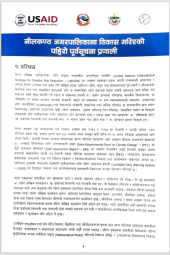Adoption of Four Pillars of Landslide Early Warning System in Neelkantha Municipality (निलकण्ठ नगरपालिकामा विकास गरिएको पहिरो पूर्वसुचना प्रणाली)
Summary
This document provides a brief on the adoption of four pillars of landslide EWS in Neelkantha Municipality along with the research catchment, LEWS components and the way forward.
The United Nations International Strategy for Disaster Risk Reduction (UNISDR) defines an EWS as a set of capacities to provide timely and meaningful warnings for individuals and communities facing hazards. Hazards, such as floods and landslides, can cause various impacts. In Nepal, landslides triggered in hilly and mountainous regions resulted in an annual average loss of 82 lives and significant property damage. The increasing trend of landslide events is attributed to climate change impacts, particularly more intense rainstorms. To address this, the LEWS has been identified as crucial for saving lives and properties. However, LEWS faces challenges due to the complexity of landslide hazard assessment and monitoring and warning services. Despite progress in understanding and predicting landslides globally, research and development efforts in Nepal are limited. FEED P. Ltd., a grantee of USAID's Tayar Nepal, has designed and implemented a cost-effective LEWS in the Arun Khola catchment, Dhading District, contributing to the scientific and technical community's interest in landslide risk reduction.
Categories:
Factsheets, Translated - English to Nepali
Publisher:
FEED
Published Year:
2022
